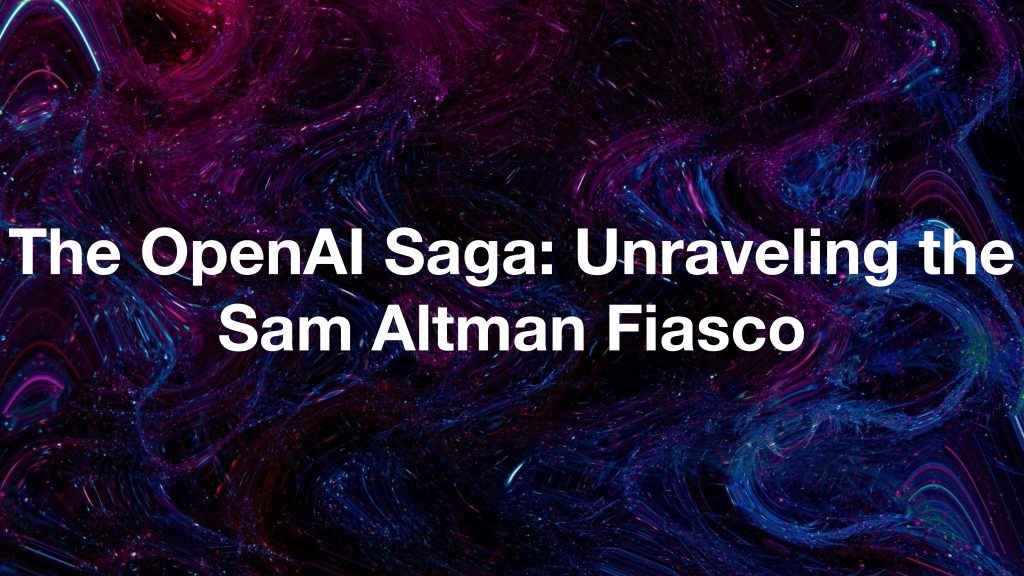In a shocking turn of events, OpenAI’s CEO, Sam Altman, was abruptly fired by the company’s board of directors. This unexpected move not only signaled a major shift for the company but also raised concerns among stakeholders and partners, including OpenAI’s largest shareholder, Microsoft.

The manner in which Altman was dismissed, without prior notification to Microsoft or the company’s employees, was highly questionable. The lack of transparency and communication only added to the confusion and uncertainty surrounding the situation. Not surprisingly, Microsoft’s stock took a hit following the news of Altman’s departure, highlighting the potential negative consequences of such hasty actions.
The crisis deepened as reports surfaced indicating that Altman and some of OpenAI’s loyalists were considering starting their own venture. This posed a significant threat to OpenAI, putting its achievements of the past several years at risk. Realizing the gravity of the situation, the board attempted to rectify its mistake by appealing to Altman to return, an embarrassing reversal of their earlier decision.
One of the factors that complicated matters at OpenAI was its peculiar board structure. As a nonprofit organization, OpenAI operated under the oversight of a board of directors, with primary responsibility towards its shareholders. However, Altman and his associates had also established OpenAI LP, a for-profit entity within the larger organization, which contributed significantly to the company’s valuation. This for-profit arm attracted investors who were eager to see a return on their investment.
It appears that Altman’s drive to innovate and bring products to market quickly may have clashed with the cautious approach favored by the board. While rapid development is common in Silicon Valley, it is a risky approach when dealing with an advanced technology like artificial intelligence (AI). OpenAI’s recent developer conference, where Altman announced plans to make AI tools available to the public, seemed to be the tipping point for the board. The potential misuse and manipulation of this technology likely raised concerns about the ethics and safety of OpenAI’s endeavors.
Altman himself acknowledged the dangers associated with AI and consistently advocated for its responsible development and regulation. He compared AI’s potential to the printing press, a powerful tool for spreading knowledge, with the risks posed by the atomic bomb. Altman’s cautious approach to AI aligns with the concerns expressed by many experts in the field, who highlight the potential negative impacts, including job displacement and the spread of disinformation.
The board’s decision to remove Altman may have stemmed from genuine concerns about the potential risks involved in OpenAI’s rapid expansion. However, the manner in which the situation was handled suggested a lack of foresight and strategic thinking. OpenAI has substantial stakeholders, including Microsoft, that invest billions in the company. Failing to involve them in the decision-making process and neglecting to have a clear plan for Altman’s exit only served to create further complications and damage trust.
Microsoft, in particular, was taken by surprise, as it believed it had made a wise investment in OpenAI’s potential. The company had integrated components of OpenAI’s technology into its core products, further deepening its ties with the AI company. The board’s actions not only angered Microsoft but also jeopardized their fruitful partnership. As reports surface, Microsoft’s demand for a board seat indicates a desire to have a more active role in OpenAI’s decision-making processes.
OpenAI now faces a challenging predicament. They could potentially have Altman return as the CEO, leading to a major culture shift within the organization. Alternatively, Altman may decide to start a competing venture, draining talent and resources from OpenAI. Whichever path is chosen, the company finds itself in a more vulnerable position than before Altman’s dismissal. Ironically, this could have been avoided if the board had taken a more measured and inclusive approach, considering the potential consequences of their actions.
Ultimately, the fallout from Altman’s firing highlights the delicate balance that companies like OpenAI must strike between innovation and responsibility. Developing AI technologies that can revolutionize industries requires careful consideration and measured progress. The tenuous nature of AI’s potential, both for positive transformation and negative consequences, necessitates a collaborative and cautious approach. OpenAI must learn from this experience and ensure that future decisions align more closely with its stakeholders’ interests, promoting responsible and sustainable AI development for the betterment of humanity.



